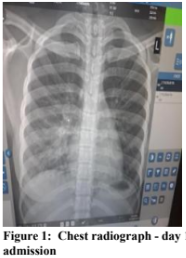Severe malaria associated acute respiratory distress syndrome: a case report
Main Article Content
Abstract
Background: Severe malaria is known to have multisystemic effects involving the brain, the kidneys, and occasionally the lungs, causing acute lung injury and, a part of the spectrum, acute respiratory distress syndrome.
Aim: To report a case of severe malaria associated with acute respiratory distress syndrome in a Nigerian teenager.
Methods: Electronic medical records at the emergency unit, the female ward, and the intensive care unit provided all the details about the patient’s clinical course for this report.
Case Report: A 15-year-old girl presented to the A&E with a fever and vague abdominal pain. Malaria parasite test was negative. Urinary tract infection was suspected, empirical antibiotics were initiated, with little relief. The fever persisted and a repeat malaria test on the second day was positive. Oral antimalarial medication was administered on an outpatient basis. She represented later the same day with fever and respiratory distress. Laboratory test showed thrombocytopaenia. Chest radiograph showed bilateral lung infiltrates. Antibiotics were continued, and oxygen supplementation with no relief. The next day, dyspnoea worsened, with severe hypoxaemia. This necessitated intensive care unit admission. Non-invasive mechanical ventilation (continuous positive airway pressure ventilation) and parenteral artesunate were initiated and given for four days with full recovery.
Conclusion: Severe malaria from plasmodium falciparum with associated acute respiratory distress syndrome (ARDS) can occur with high morbidity and mortality. This necessitates prompt recognition, intervention, and early intensive care unit admission, initiation of continuous positive airway pressure ventilation (CPAP), and intravenous antimalarial treatment for a good outcome.
Downloads
Article Details

This work is licensed under a Creative Commons Attribution-NonCommercial-ShareAlike 4.0 International License.
The journal grants the right to make small numbers of printed copies for their personal non-commercial use under Creative Commons Attribution-Noncommercial-Share Alike 3.0 Unported License.
References
Shekarau E, Uzoanya M, Ogbulafor N; Severe Malaria Working Group. Severe malaria intervention status in Nigeria: workshop meeting report. Malar J 2024;23(1):177.
Bittaye SO, Jagne A, Jaiteh LE, Nadjm B, Amambua-Ngwa A, Sesay AK, et al. Clinical manifestations and outcomes of severe malaria in adult patients admitted to a tertiary hospital in the Gambia. Malar J. 2022;21(1):270.
Wombo JB, Ibinga E, Oyegue-Liabagui SL, Limoukou RK, Okouga AP, Mounioko F, et al. Severe malaria in children and adolescents in Southeast Gabon. BMC Infect Dis 2023;23(1):207.
Piastra M, Picconi E, Genovese O, Ferrari V, Morena TC, Valentini P, et al. Complicated falciparum malarial ARDS requiring noninvasive support. Pediatr Infect Dis J 2024;43(3):e96–e99.
Van den Steen PE, Deroost K, Deckers J, Van Herck E, Struyf S, Opdenakker G. Pathogenesis of malaria-associated acute respiratory distress syndrome. Trends Parasitol 2013;29(7):346–358.
Bos LD, Ware LB. Acute respiratory distress syndrome: causes, pathophysiology, and phenotypes. Lancet. 2022;400(10358):1145-1156.
Duffy F, Bernabeu M, Babar PH, Kessler A, Wang CW, Vaz M, et al. Meta-analysis of Plasmodium falciparum var signatures contributing to severe malaria in African children and Indian adults. mBio 2019;10(2):e00217-19.
Tomassi MV, D'Abramo A, Vita S, Corpolongo A, Vulcano A, Bartoli TA, et al. A case of severe Plasmodium ovale malaria with acute respiratory distress syndrome and splenic infarction in a male traveller presenting in Italy. Malar J 2024;23(1):93.
Hoffmeister B. Respiratory distress complicating falciparum malaria imported to Berlin, Germany: incidence, burden and risk factors. Microorganisms 2023;11(6):1579.
Mousa A, Al-Taiar A, Anstey NM, Badaut C, Barber BE, Bassat Q, et al. The impact of delayed treatment of uncomplicated P. falciparum malaria on progression to severe malaria: a systematic review and a pooled multicentre individual-patient meta-analysis. PLoS Med 2020;17(10):e1003359.
World Health Organization. WHO Guidelines for malaria. WHO/UCN/GMP/2021.01 Rev. 1. Geneva: World Health Organization, 2021.
Tiiba JI, Ahmadu PU, Naamawu A, Fuseini M, Raymond A, Osei-Amoah E, et al. Thrombocytopenia a predictor of malaria: how far? J Parasit Dis 2023;47(1):1–11.
Chandra S, Chandra H. Role of haematological parameters as an indicator of acute malarial infection in Uttarakhand State of India. Mediterr J Hematol Infect Dis 2013;5(1):e2013009.


